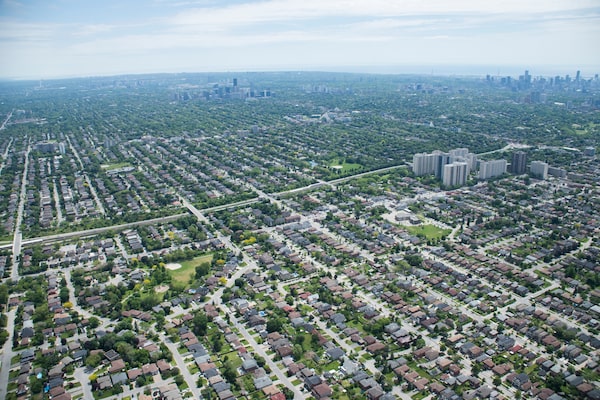
Homes in Toronto's northwest area on June 17, 2019.Fred Lum/The Globe and Mail
This winter Toronto homeowners were reminded to declare that they are living in the places they live in. In order to avoid paying the city’s vacant-home tax, they needed to submit a formal declaration saying they were actually occupying their own homes.
Not surprisingly in a vast, busy city, the message didn’t get through to everyone. Many residents misunderstood the order, didn’t notice the reminders or simply forgot. The result is a big old mess. Thousands of households are now being dinged for the tax, which is calculated at 1 per cent of a home’s value – no small change, given Toronto real estate prices. Getting a notice that says you are not living in your own house and must start paying the city for the crime often comes as a considerable shock, especially to elderly long-term homeowners who did not imagine they would ever have to prove their occupancy.
City hall is being flooded by angry complaints from residents. Among them are some who say they actually met the March 15 deadline for declaring their homes, er, non-vacant but got a hefty tax bill from the city anyway.
City hall should have seen this train wreck coming. City council voted in 2021 to impose the tax. It took effect in 2022. It applies to homes that are not the principal residence of the owners or tenants for six months or more of the year. The rate will rise to 3 per cent for 2024.
Several other cities have taken the same step. The idea is to discourage homeowners, particularly absent investors, from leaving properties unoccupied in the midst of a nationwide housing crisis. In Toronto it has the added attraction of topping up the city’s depleted coffers, last year to the tune of $54-million.
The trouble from the start was determining who needed to pay it. Knocking on every door in the city to make sure someone was home was not an option, so authorities had to rely on homeowners to attest that they were living in their dwellings and not leaving them empty. That showed a touching, but unfortunately misplaced, faith in humanity.
Last year about 43,000 homes were declared vacant simply because the owners did not submit a declaration of occupancy. Despite the city’s attempts to get the word out this year, only around two-thirds of homeowners had declared as of this winter. Even extending the deadline didn’t help much.
City hall is trying to make amends. It says those who were billed the vacancy tax for an occupied home can inform the city through an online portal. In the meantime, some city councillors are saying, they should not bother to pay the tax.
Mayor Olivia Chow is asking residents for forgiveness and promising to improve the system for next year. A better idea would be to chuck the whole thing. Based on this year’s fiasco, the tax may simply be more trouble than it is worth. Determining whether thousands and thousands of homes are vacant or occupied is proving to be an endlessly awkward and costly task. It is by no means clear that the city has a fix.
As a matter of principle, the tax is unsavoury. People should be able to do more or less what they wish with properties they own. If they want to leave them vacant for a while as they wait for a better selling price or get ready to move here from another city or whatever reason, that should be their right.
Like taxes on speculation and foreign ownership, the vacant-home tax places the blame for our home-grown housing crisis on shadowy forces like real-estate chisellers and overseas buyers. Let’s not forget that many investors in Toronto’s housing market rent out their condos and other properties, thus providing more rental housing and helping ease, not worsen, the housing crisis. Homes that stand vacant are only a sliver of the housing-shortage problem in any case. Toronto would be wise to look for solutions elsewhere.
 Marcus Gee
Marcus Gee